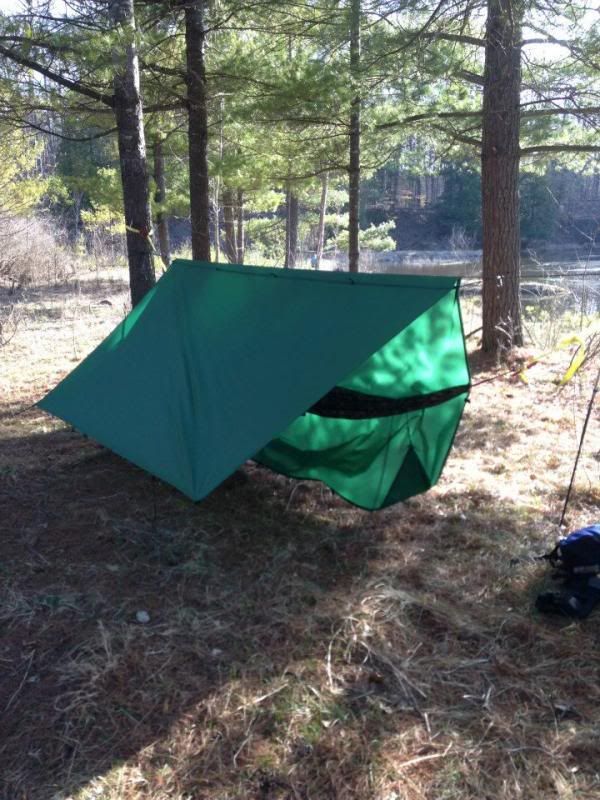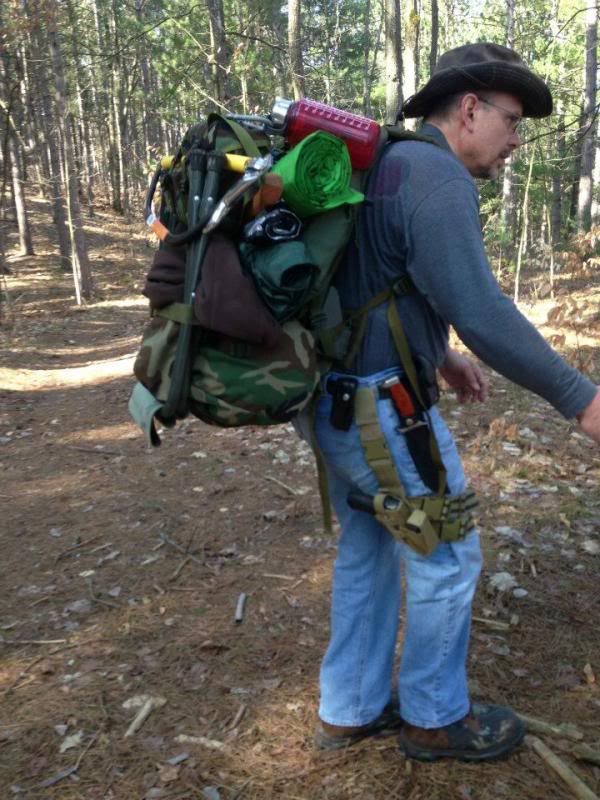Everything you are going to use must be packed into your camp, with maybe the exception of water. Shelters, sleeping gear, food and supplies all have to be carried. Depending on the distance to your camp will determine how much or little you take with you. Or how much you bring may determine how far in you go. The choice is up to you. There are other choices too. Lighter gear substituted for heavier gear. The three main things to reduce your bas pack weight are: Pack, Shelter and Sleeping bag.
 The first to tackle for me was the Sleeping bag. Down can be very expensive, but light and small. For the summer I opted for the Lafuma light and warm 600 for $100 from Dunham’s Sporting Goods. Now I’m a “well rounded” individual, so it fits snugly. But it packs down to about the size of a 32 oz. Nalgene and weighs just over 1lb. I also acquired the M.S.S. or Military Sleep System, 2 bags and a Gore-Tex bivy which will run you @ $85 at gunshows or up to $150 at surplus stores. The green lightweight patrol bag is almost as small as the Lafuma, weighs about the same and is comfortable to about 50*F. The black medium bag is a little larger, weighs in @ 4 lbs. and is comfortable down to about 25*F. Combine them together with the Bivy and they get me down to 15*F. I have been down to -4*F but with long johns and Fleece bibs on. So you can get the weight down from the car camping / slumber party sleeping bag without spending a fortune. One advantage of the M.S.S. is that the Gore-Tex Bivy can replace or enhance your shelter.
The first to tackle for me was the Sleeping bag. Down can be very expensive, but light and small. For the summer I opted for the Lafuma light and warm 600 for $100 from Dunham’s Sporting Goods. Now I’m a “well rounded” individual, so it fits snugly. But it packs down to about the size of a 32 oz. Nalgene and weighs just over 1lb. I also acquired the M.S.S. or Military Sleep System, 2 bags and a Gore-Tex bivy which will run you @ $85 at gunshows or up to $150 at surplus stores. The green lightweight patrol bag is almost as small as the Lafuma, weighs about the same and is comfortable to about 50*F. The black medium bag is a little larger, weighs in @ 4 lbs. and is comfortable down to about 25*F. Combine them together with the Bivy and they get me down to 15*F. I have been down to -4*F but with long johns and Fleece bibs on. So you can get the weight down from the car camping / slumber party sleeping bag without spending a fortune. One advantage of the M.S.S. is that the Gore-Tex Bivy can replace or enhance your shelter.
For Shelter I use a tarp. I have used everything from a cheap polypropylene tarp from Harbor Freight for $7 to my Etowah Poly coated Nylon 10X10 for $55. I usually add a hammock to my shelter for comfort. Depending on the season will depend on which hammock I take. My go to tarp is my Etowah 10’ X 10’ weighing in at 1 lb. 8 oz. In the winter I use a Byer Traveler Hammock, $20. It’s a 9’ long gathered end hammock weighing in at @ 18oz. I use a 1” ¾ length Thermarest under me with a Trek Light Gear wing system. Basically it just adds about 4” of light padding over your shoulders with a sleeve to slide your pad into. During the months that the Michigan State Pest, the Mosquito is alive and well I use my Hennessy Asym Deluxe with built in mozzy net weighing in @ 2lbs, $150+. It’s a little heavier than the Byer, but more comfortable and roomier.
Now you have to carry everything in something. This is where I see more people spend a lot of money buying and re-buying. If you are new and not sure what you will need or want it can be difficult to guess what size pack you will need. For a weekend trip a 50L pack should be sufficient for most people. If you get one that you can strap things onto the outside you can get away with more “things” The first thing to consider is your sleeping bag. Where is it going to ride? I prefer mine in the middle of my pack. So it goes in the main compartment, leaving the bottom compartment for my clothes and other things. They are easier to access there anyway. The easiest way to measure for a pack is to put all of your gear in a box, mark how high it is and measure it out for the volume it takes up. But we are packing on a budget. Search social media sites and trade sites like Craigslist for a pack that is efficient for the size you need. I was able to trade up to a 75L Kelty bag. As long as you remember that you DO NOT HAVE to fill it, bigger is OK. The sacrifice will be in the unneeded weight increase. My Kelty weighs in at 4 lbs. 12 oz. An old Scout aluminum external frame pack will be sufficient. Or even a surplus army frame and pack, though heavy they are rugged. Opt for the medium though due to the large hanging the weight too far back causing you to have to lean more to the front.
The rest of the gear can be improvised and upgraded over time. Just remember when given the choice between two items, pick the lighter one. If there is a reason you don’t like the lighter option, trade it for something else. Same thing can be said for the heavier option. Unless there is a reason for having it like using it when you bring someone else with you or for a loaner, trade it. There are other options as well. Thrift stores can have treasures in them if you know what you are looking for. I have found everything from sleeping bags, cast iron pans to trekking poles. My latest find are a set of Goode Carbon Fiber ski poles. Retail for this particular set was between $95 and $150 depending on where you looked since they aren’t made anymore. My cost, $3.00! I snatched them up as quickly as I could. I prefer a solid pole over a collapsing one anyway. They work great for setting up my tarp, attaching my video camera and hiking. Wool clothing is another item I have scored from a thrift store. Lightweight wool sweaters, wind breakers, wicking shirts even rain gear. It’s all a matter of timing. I visit the several stores in my area a couple of times per month. A lot of times I walk out empty handed. It’s not about the things you don’t see, but the things you DO find.
Every time I go out, when I come home I go over my kit and look for things I did not use. They go on a list of things to leave home next time. You have to be realistic though in you thinking. Just because it didn’t rain doesn’t mean you can leave the rain gear home next time. Ask yourself why you didn’t use an item. Was it too heavy? Does it not perform well? Is it inconvenient? For instance a rain suit is only good for a downpour. Otherwise you will get just as wet from perspiration on the inside. Another option for drizzle or light rain would be a small umbrella. A rain suit will only cover you, not your pack. A poncho will cover both, but your legs usually get wet from the rain dripping off. An umbrella will keep most of the rain off of you and your pack in most conditions. It can be stored in an outside pocket where it is easy to reach without taking your pack off. Making it more likely to be used and keeping you dry. No need to spend a lot of money on one either. Being in the woods you are going to be rubbing it against the trees and snagging it up. So you are going to replace it. Spend your money wisely and get a medium quality less expensive one.
Shoes or hiking boots are another area people say they need before they can go out. I prefer running shoes over clunky heavy “Hiking Boots”. They are light weight, dry quickly and are less expensive. I prefer quick drying over waterproof. Your feet are going to get wet, whether it is from an outside source like water puddles, streams or dew. A pair of waterproof boots is only going to keep any water that does get into them, in. I would prefer to allow the water to escape as quickly as it came in. Another problem with waterproof boots is that they don’t allow perspiration to escape either. So your feet are going to be wet from the inside at the end of the day either way. If you have lightweight running shoes they will be able to air out faster and more efficiently. Meaning you should have dry shoes by morning without running the risk of burning them up by the fire.
Be sure to subscribe as we cover more items and ways to shave weight from your pack.



No comments:
Post a Comment